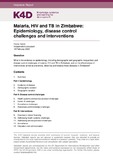| dc.contributor.author | Haider, Huma | |
| dc.date.accessioned | 2022-04-11T10:16:02Z | |
| dc.date.available | 2022-04-11T10:16:02Z | |
| dc.date.issued | 2022-02-18 | |
| dc.identifier.citation | Haider, H. (2022). Malaria, HIV and TB in Zimbabwe: Epidemiology, disease control and interventions. K4D Helpdesk Report 1086. Brighton, UK: Institute of Development Studies. DOI: 10.19088/K4D.2022.037 | en |
| dc.identifier.uri | https://opendocs.ids.ac.uk/opendocs/handle/20.500.12413/17304 | |
| dc.description.abstract | Zimbabwe is a lower-middle income country in southern Africa with a population of approximately 15 million. Malaria, HIV and tuberculosis (TB) remain important public health concerns in the country, despite significant progress over the past two decades.
Malaria incidence has declined markedly between 2003 and 2019 (by 81% from 2003 to 2015), but has risen since, particularly during the Covid-19 pandemic (Gwitira et al., 2020; Tapera, 2019).
Zimbabwe is one of 22 high burden countries for HIV (Chimwaza et al., 2021). While HIV prevalence has declined from 27.2% in 1998 to 11.9% in 2020, Zimbabwe has the fifth highest HIV prevalence in sub-Saharan Africa (UNAIDS, 2020; UNDP, 2020b).
Zimbabwe is among the 14 high burden countries for TB, multi-drug resistant TB and TB-HIV coinfection (UNDP, 2020c). TB case incidence and mortality have declined by over 60% between 2011 and 2018, however, TB mortality remains high, at 15% among notified TB clients (Global Fund, 2020; UNDP, 2020b).
This rapid literature review highlights key aspects of the epidemiology of malaria, HIV and TB in Zimbabwe and challenges in prevention, detection and treatment; and surveys select interventions that seek to address these challenges. It has not been possible to provide a comprehensive and dedicated review of the many interventions in Zimbabwe in this report.
The Covid-19 pandemic is addressed as a key control challenge for malaria, HIV and TB – with various Covid-19 related issues sign-posted throughout the report. Covid-19 mitigation measures have affected the delivery and utilisation of HIV, TB, and malaria services: the largest effect is projected to result from interruption of antiretroviral therapy (ART); decline in TB case detection; and interruption of preventive indoor residual spraying (IRS) and long-lasting insecticidal net (LLIN) distribution campaigns, respectively (Amimo et al., 2020). | en |
| dc.description.sponsorship | Foreign, Commonwealth and Development Office (FCDO) | en |
| dc.language.iso | en | en |
| dc.publisher | Institute of Development Studies | en |
| dc.relation.ispartofseries | K4D Helpdesk Report;1086 | |
| dc.rights.uri | https://creativecommons.org/licenses/by/3.0/igo/ | en |
| dc.subject | Health | en |
| dc.subject | HIV/AIDS | en |
| dc.title | Malaria, HIV and TB in Zimbabwe: Epidemiology, Disease Control Challenges and Interventions | en |
| dc.type | Helpdesk | en |
| dc.rights.holder | © Crown copyright 2022 | en |
| dc.identifier.doi | 10.19088/K4D.2022.037 | |
| dcterms.dateAccepted | 2022-02-18 | |
| rioxxterms.funder | Default funder | en |
| rioxxterms.identifier.project | K4D | en |
| rioxxterms.version | VoR | en |
| rioxxterms.versionofrecord | 10.19088/K4D.2022.037 | en |
| rioxxterms.funder.project | 0986883a-6d0f-4bb8-9c46-5e0682934d65 | en |


